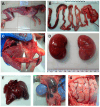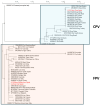First Description of a Carnivore Protoparvovirus Associated with a Clinical Case in the Iberian Lynx (Lynx pardinus)
- PMID: 40218419
- PMCID: PMC11988045
- DOI: 10.3390/ani15071026
First Description of a Carnivore Protoparvovirus Associated with a Clinical Case in the Iberian Lynx (Lynx pardinus)
Abstract
One of the main threats for the survival of the Iberian lynx is infectious disease. Feline parvoviruses cause often fatal diseases in cats and have been isolated from different species of Felidae and other carnivores. The present study is the first description of a parvoviral sequence isolated from the brain of an Iberian lynx which died four weeks after being transferred to a quarantine centre from a hunting estate in Castilla-La-Mancha (southern border of the Iberian plateau). Four days prior to death, it had developed anorexia and muscle weakness. The nucleotide sequence, at 4589 nt long (GenBank PP781551), was most proximal to that isolated from a Eurasian badger in Italy but also showed great homology with others from cats and other carnivores isolated in Spain and Italy, including that from a cat sequenced by us to elucidate the origin of the infection, which has not been clarified. The phylogenetic analysis of the capsid protein, VP2, which determines tropism and host range, confirmed that the lynx sequence was most proximal to feline than to canine parvoviruses, and was thus typed as Protoparvovirus carnivoran1. More studies, including serology, are needed to understand the pathogenesis of this infection.
Keywords: FPV; Iberian lynx; PCR; complete sequence; faeces; parvovirus.
Conflict of interest statement
The authors declare no conflicts of interest. The management team of the hunting estate had no role in the design of the study; in the analyses, or interpretation of data; or in the decision to publish the results.
Figures




Similar articles
-
Disease Surveillance during the Reintroduction of the Iberian Lynx (Lynx pardinus) in Southwestern Spain.Animals (Basel). 2021 Feb 19;11(2):547. doi: 10.3390/ani11020547. Animals (Basel). 2021. PMID: 33669869 Free PMC article.
-
Disease threats to the endangered Iberian lynx (Lynx pardinus).Vet J. 2009 Oct;182(1):114-24. doi: 10.1016/j.tvjl.2008.04.005. Epub 2008 Jun 13. Vet J. 2009. PMID: 18555712 Free PMC article.
-
Pseudorabies virus infection (Aujeszky's disease) in an Iberian lynx (Lynx pardinus) in Spain: a case report.BMC Vet Res. 2017 Jan 5;13(1):6. doi: 10.1186/s12917-016-0938-7. BMC Vet Res. 2017. PMID: 28056966 Free PMC article.
-
Feline leukemia virus infection: a threat for the survival of the critically endangered Iberian lynx (Lynx pardinus).Vet Immunol Immunopathol. 2010 Mar 15;134(1-2):61-7. doi: 10.1016/j.vetimm.2009.10.010. Epub 2009 Oct 14. Vet Immunol Immunopathol. 2010. PMID: 19896221 Free PMC article. Review.
-
Patterns of Exposure and Infection with Microparasites in Iberian Wild Carnivores: A Review and Meta-Analysis.Animals (Basel). 2021 Sep 16;11(9):2708. doi: 10.3390/ani11092708. Animals (Basel). 2021. PMID: 34573674 Free PMC article. Review.
References
-
- IUCN . Recovery of the Iberian Lynx: A Conservation Success in Spain 2024. IUCN; Gland, Switzerland: 2024.
-
- Spanish Ministry of Ecological Transition and Demographic Challenge (Fauna de Vertebrados: Mamíferos) (Fauna of Vertebrates: Mammals) [(accessed on 27 March 2025)]. Available online: https://www.miteco.gob.es/content/dam/miteco/es/biodiversidad/temas/inve....
LinkOut - more resources
Full Text Sources
Research Materials
Miscellaneous

